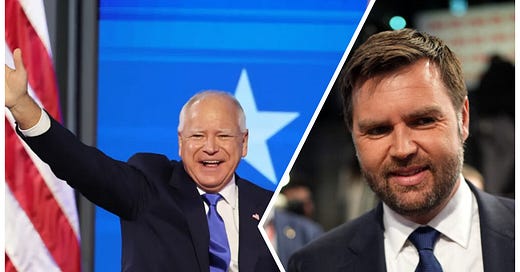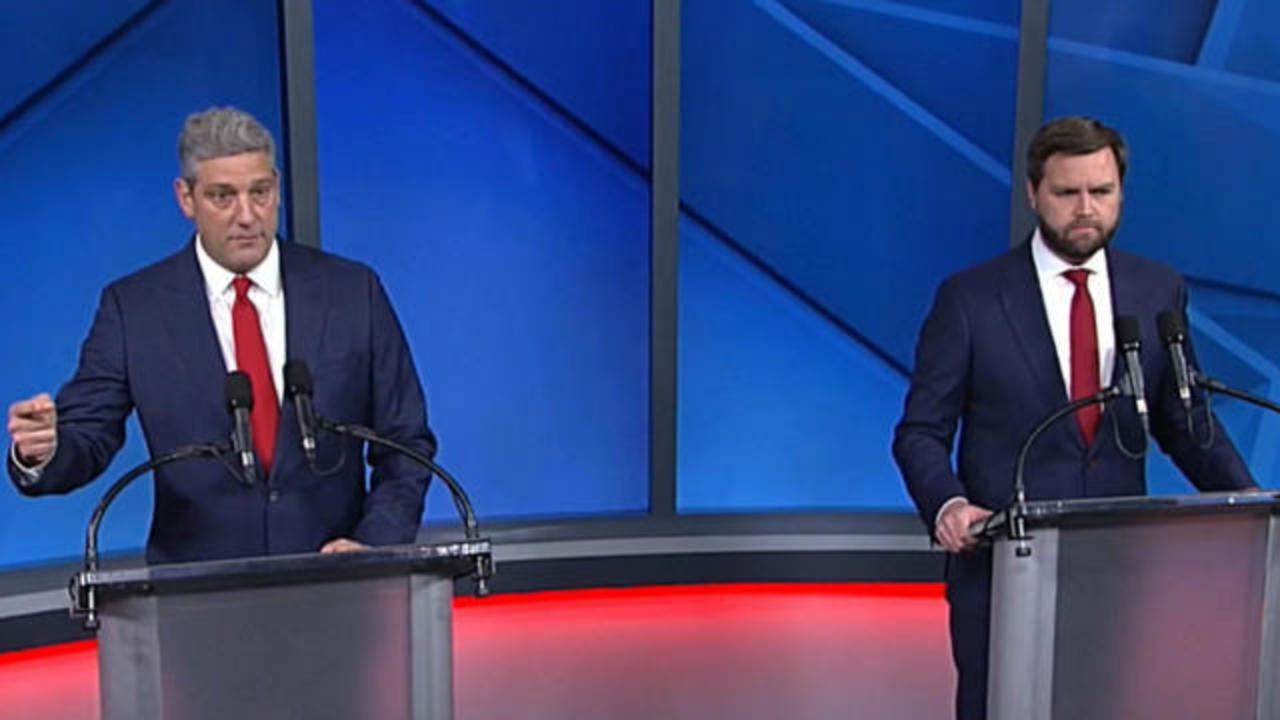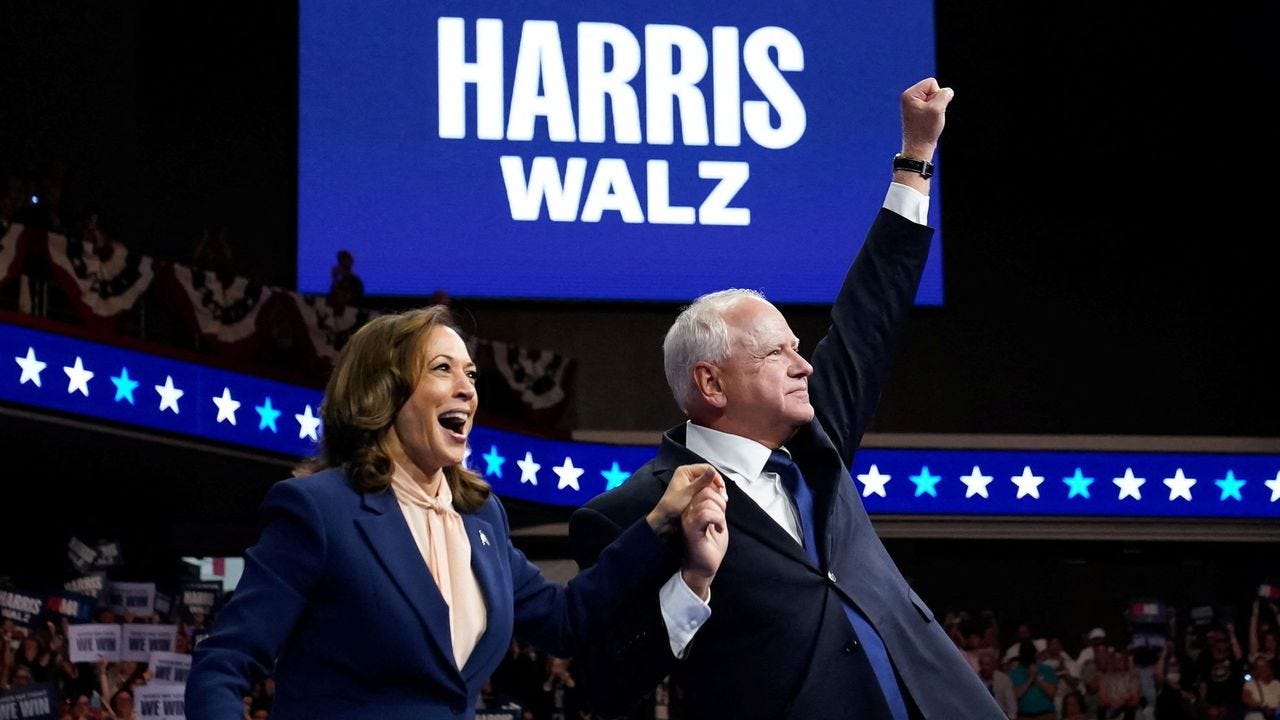Vance and Walz: A Study in Contrasts
Two very different running mates and their two very different strategies.
Hey folks, happy Thursday.
Welcome back to TOTS, where today we’re going to be taking a look at the two candidates for Vice President in this election cycle. It’s true—VP is a thankless position, and traditionally one, in a campaign sense, best described by the term “Do No Harm.” While the selection of a running mate receives plenty of attention, and the more interesting (AKA damaging ones) can become infamous for their effect on a campaign, most failed running mates often become a trivia answer for history. Do you remember Tim Kaine? Cool, now tell me a single thing about him.
Anyways, the VP selections have received a bit more attention this year for a couple of reasons: (1) Both candidates ultimately went with the “unconventional” pick; that is to say, they picked the candidate that was generally considered a bit of a wildcard. (2) Both campaigns have gone after the other’s running mate hard, much harder than we’re used to. So today, let’s compare the two running mates, their different philosophies, and how each may ultimately impact the November election.
Two Contrasting Backgrounds
I’ve written in detail about Vance, and I’ve touched on Walz in past Veepstakes posts. I’ll quickly quote what I said in these posts to provide a summary of their backgrounds, which you are surely becoming pretty familiar with.
On Vance:
There are a number of different angles I could take to talk about Vance, who, at 39, is very much a representative of the “new” GOP. Vance is actually quite new to the elected political area, and he is only in his second full year as a U.S. Senator from Ohio. Prior to being elected, however, Vance had already made a name for himself in conservative circles. A former U.S. Marine and Yale Law grad, Vance started out as a Bay Area venture capitalist, and he became associated with right-wing donors like Peter Thiel. But then, in 2016, Vance wrote a memoir: Hillbilly Elegy: A Memoir of a Family and Culture in Crisis. The book, which you may very well have heard of, was a polarizing bestseller. While many praised Vance for his depiction of the social values and issues of life in Middletown, Ohio, a former industrial city, others were more skeptical. Criticism focused on the major generalizations Vance made about white Americans in poverty, as he focused on his own family’s Protestant values or the policy proposals he embraced. But remember, this was 2016. In the wake of Trump’s victory, many people looked to stories like this for an explanation, however flawed they may have been.
Vance might not have wanted that. Like many on this list, Vance was once an avowed Trump critic. He called himself a never-trumper and compared Trump to Hitler. And like many on this list, Vance reinvented himself quite quickly. After the massive success of Hillbilly Elegy, Vance moved to Ohio to lay the groundwork for a bid for office. It’s not totally clear what changed outside of that, but in 2022, when Vance launched a bid for Senate, he branded himself as a Trump loyalist, embracing the similarities in their populist rhetoric and earning himself a Trump endorsement and a Senate seat. As a Senator, Vance has established himself as one of Trump’s firmest allies, even appearing at his New York trial.
On Walz:
Walz actually began his career as a geography teacher, with a brief break to serve in the Army. Walz, a local high school teacher and football coach, won a surprise election to Congress in 2006 and quickly became a commodity in his district, serving for over a decade, even as Trump easily won his rural seat in 2016. Walz ultimately retired in 2018 to run for Governor and, since then, has put together, as you may have seen a pattern of, an impressive progressive track record. Legal weed, universal background checks, codifying abortion rights, paid family leave, and free school lunches are among the things Walz has gotten done since getting a trifecta in state government.
If you’re wondering why the Walz bio is so much shorter, well, to be completely honest, when I wrote the first draft of my Harris veepstakes post, I forgot to mention him entirely and only added him in later. Since I didn’t think he was going to be the pick, I didn’t really think I needed to go in-depth on him, which, well, whoops. Obviously, one of the things you immediately note is that there are some crossovers here: Both candidates were born and raised in small midwestern towns (Walz was born in Nebraska), and both ultimately left to serve in the military.
One of the biggest Republican hits on Walz has been over his military service. Walz, who served in the National Guard, submitted his retirement paperwork just a couple of months before his unit deployed to Iraq. Vance, who did deploy to Iraq in 2005 with the Marines, has attempted to brand Walz as a coward and accused him of stolen valor, but it’s worth noting that Walz hasn't really cited any actual battle experience, and Vance himself served in a non-combat role. While it’s been one of the consistent Republican attacks on Walz so far, it doesn’t really seem to be landing in the way Republicans hoped—even if Walz at times exaggerated his service (and the evidence for this is shaky at best) or abandoned his unit (which there is no evidence of, with Walz already running for Congress by the time his unit deployed), this isn’t really a juicy stolen valor story filled with lies or misdeeds.
On the other hand, Vance’s background has come under attack from Walz for the different path he chose after the military. After coming home, Vance went to Ohio State before going to Yale Law School, moving to the Bay Area, and, as mentioned earlier, writing his now-famous book. In his DNC speech, Walz referenced the fact that “none of [his classmates] went to Yale.” He’s also accused Vance of writing a book
”trashing his own community,” likely referencing the criticisms of small-town American life and values present throughout Hillbilly Elegy.
Once again, neither Vance nor Walz were the conventional picks. Most media talking heads seemed to think Trump would go with North Dakota Gov. Doug Burgum, a boring but moderate, rich dude. On the other hand, they predicted Kamala Harris would go with Pennsylvania Gov. Josh Shapiro, a popular moderate in a swing state. Many immediately declared that both candidates had made the wrong choice in the wake of their selections because, well, talking heads tend to get attached to their talking points. Unlike Burgum, Vance is no moderate—I've written at length about his ideological history. And while Walz is no Bernie Sanders, his record as Governor—which I described earlier—would by all means be considered a progressive one.
But despite all the comparisons and back-and-forth, something is becoming very clear throughout the course of this election. These are two very different candidates, and they have sent their respective campaigns in very different directions. Let’s look at it.
Conflicting Electoral Histories
By far, the most important factor considered in the running mate decision is, “How can this person help me win?” In general, most candidates are satisfied to add someone who just doesn’t hurt their chances. Very few people actually select a candidate because they like their running mate, but deciding against someone because you don’t like their running mate isn’t without precedent, as Republicans found out the hard way in 2008. So, with all that said, it’s always important to examine how a running mate has fared in their own elections over the years to answer the key question of “Does his own state like him?”
I've already done this sort of exercise with Vance. I won’t repeat everything here, but the key detail is this. In 2020, Biden won the popular vote with 4.5 points. Trump won Ohio by 8 points, so Ohio was 12.5 points to the right of the country. In 2022, Vance won by just over 6 points in a redder environment. It’s hard to quantify how much redder 2022 was than 2020 nationally because there was no presidential election, but Republicans won the combined House vote nationally by 1.6 after Democrats won it by 3.4 in 2020. In Ohio, the combined House vote actually shifted to the left, but Republicans still won it by 13-some points, so Vance underperformed that. Anyway, you slice it; Vance underperformed in an environment he should’ve easily won in, and he needed $120 million from Republicans to do it. Split-Ticket found that Vance underperformed his projected margin by over 5 points.
Now, let’s look at Walz, whose own electoral record actually took some flak because of his presence in a non-swing state (Of course, Ohio isn’t one either) and comparisons to Shapiro’s dominant performances. However, Walz, who has a much longer record than Vance, is far from a slouch. Walz represented a red-leaning district in Congress but floated in on the 2006 blue wave and then just kept winning. Walz held onto his seat in massive red wave years in both 2010 and 2014. That 2010 is particularly impressive—despite a massive swing right nationwide, Walz won the district by more than Obama did in 2008. He won re-election in 2016 while Hillary Clinton lost the seat by a whopping 15 points, and he carried it in his bid for Governor in 2018 even as Republicans flipped it. Walz’s first bid for Governor saw him win by over 11 after Clinton had just won by 1.5 (Meaning Minnesota voted narrowly to the right of the nation in 2016), but to be completely fair, 2018 was also a big blue wave year (Although, unlike a certain someone, Walz ran in line with House Democrats in his state). In 2020, Biden won the state by 7, more than his 4.5-point win nationally. Now, based on the 2020 to 2022 rightward trend we discussed earlier, you would expect Walz’s margin to decrease, and it did, to around 7.6 points. However, you will notice that this means Walz still won more than Biden did despite the national environment shifting to the right. And this time, he significantly outperformed House Democrats in MN.
So, let’s put all this together. No, Walz is not from a swing state, nor is he likely to be a major addition to the ticket from an electoral standpoint. But despite some trying to push the narrative that Walz is a weak candidate, there’s no evidence to support that. On the contrary, he’s actually been a career electoral overperformer and, even at his worst, has performed about in line with where you’d expect Democrats to. On the other hand, Vance’s only campaign in his life was a massive underperformance that was buoyed by hundreds of millions of dollars pouring in from Republicans.
This difference has played out in approval rating polls of the two candidates. As it stands, 538’s average shows Walz with 39.2% approve and 35.1% disapprove, making him more popular than Kamala Harris. On the other hand, J.D Vance stands at 44.4% disapproval and 34.3% approval, making him less popular than not only Walz but Trump himself. (It is worth noting that both candidates still have lower name recognition than the presidential candidates, which is to be expected but could affect their numbers).
Now, let’s take a look at how the two campaigns have actually treated their running mates so far because it says a lot more than you might realize about whether or not they’re having “buyers’ regret.”
Impact on the Campaign
We’re now about two months into Vance’s campaign for VP and about a month into Walz’. As a result, we are in a good position to start making some larger conclusions about how these selections have affected their respective campaigns.
To put it simply, Tim Walz has been a boon to the Harris campaign, helping them refine their message while uniting the party’s base. Vance has been a drag on the Trump campaign, with a laundry list of controversial comments and stances that have forced Trump to, at times, distance himself from his running mate.
If you don’t believe me, just look at how much time Vance spends campaigning on his own (Which, to be fair, is in part because Trump has not run a very intensive campaign schedule himself lately). Vance and Trump have done a couple of rallies together and did an early join interview, but outside of that, Vance has spent a lot of time campaigning on his own. Trump has dodged questions about Vance's fitness to serve. It’s worth noting that the previous message about the conventional wisdom that Trump would pick Burgum. While we don’t know exactly what Trump himself thought, and he did endorse Vance in 2022, Don Jr. was reportedly Vance's biggest backer to his father. Recently, Trump has appeared more interested in campaigning with Robert F. Kennedy Jr. The campaign has had to tamp down on questions that Trump might drop Vance from the ticket (Which, at this point, is nearly impossible). There’s just an awkward vibe around the whole thing; you get the feeling that Trump was perhaps leaning in a different direction before his sons and other aides pushed him toward Vance. I’m not in the business of speculation, but it’s not exactly out of line to think that Trump may have even preferred Kennedy.
On the other hand, Walz has been present at nearly all of Harris’ recent campaign events. The two did a widely covered swing state together, and while Walz has held his own events as well, the two are increasingly connected together, the opposite of the Trump-Vance ticket. More importantly, look at the impact Walz has had on the campaign’s messaging. Walz’s early attack line on Trump and Vance as “weirdos” has become a prime Democratic message. His slogan, “Mind your own damn business,” may as well be the Harris-Walz slogan. And Walz was the first to emphasize the “joyful” nature of the Democratic ticket, which has become a term Dem officials are tripping over themselves to use. As I mentioned earlier, there is little sign that Republican attacks on Walz’s military service or legislative record have done any damage to his image.
On the other hand, Vance’s comments about “childless cat ladies” and a recent attack on “childless teachers” have seemingly done the exact opposite: They’ve energized Democrats against him. It’s possible Vance had some appeal to certain groups, but those groups have yet to emerge, and Vance’s image has taken hit after hit. Walz has also seemed more comfortable on the trail than Vance, which isn’t a surprise—Walz is an experienced politician, while Vance has only run one campaign in his life to date, and based on the results in that race, he didn’t run it particularly well. A recent video of Vance in a donut shop has gone viral for this exact reason: As a politician, you simply cannot look uncomfortable around people. Fair or not, it’s part of the game, and Vance has struggled with it to date. Tim Walz is not an Obama-level orator, but every anecdote that comes out about him seems to reference his affable personality. To voters, especially with lesser-known candidates like those for VP, these personal images matter.
Conclusion
Look, we still don’t know how this election is going to play out. Regardless of the result, the choice of VP is unlikely to be the decisive factor (Although there will surely be some Democrats who share “told you so” if Harris loses Pennsylvania). However, it’s clear that despite the early narrative, the two running mates are simply not comparable at all. One has helped their campaign; the other has hurt it. And the latter is simply not an option a campaign can afford.
I’ll close with another theory about why Trump picked Vance. Trump picked Vance, in part, because he was preparing for a landslide win over Biden. Vance, at 39 years old, is the type of person who could keep Trump’s movement going after a theoretical second term. One of the biggest things that has damaged Trump’s campaign ever since Biden dropped out is the simple flaw of complacency. In 2016, Hillary Clinton spent the closing weeks targeting states she had little chance of winning in an effort to win a landslide victory and send a statement when it turns out she should’ve focused on winning the election. Trump may have crushed Biden, but we’ll never know. Now Biden is gone, and Trump’s campaign seems wholly unprepared for a competitive race. And very little has encapsulated that more than J.D. Vance.







